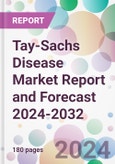Tay Sachs Disease Market Outlook
The Tay Sachs disease market size was valued at USD 2.1 billion in 2023, driven by the increasing investment to development effective treatment alternatives across the major markets. The market size is anticipated to grow at a CAGR of 5.6% during the forecast period of 2024-2032 to achieve a value of USD 3.4 billion by 2032.Tay Sachs Disease: Introduction
Tay-Sachs disease is a rare, inherited neurodegenerative disorder. It's caused by the absence of a vital enzyme, hexosaminidase A, leading to the accumulation of a fatty substance (GM2 ganglioside) in nerve cells in the brain and spinal cord. This accumulation progressively destroys nerve cells, affecting mental and physical abilities. Symptoms, appearing in infancy, include muscle weakness, motor skill regression, and severe neurological impairment. Currently, there's no cure, with treatment focusing on managing symptoms and providing supportive care.Key Trends in the Tay Sachs Disease Market
Significant investment in research is focused on understanding the genetic and biochemical basis of Tay-Sachs disease to develop potential therapies. Clinical trials are exploring gene therapy, enzyme replacement therapies, and substrate reduction therapies as potential treatments.Many regions have implemented or are advocating for newborn screening programs to detect Tay-Sachs disease early. Early diagnosis allows for prompt intervention and management, even though options are currently limited to supportive care.
As Tay-Sachs is a progressive, debilitating condition, there's a focus on improving the quality of life of patients and families. This includes advancements in palliative care, physical therapy, and nutritional support, as well as services to assist families in managing the emotional and practical challenges of the disease.
With Tay-Sachs being an inheritable condition, genetic counseling services are essential. They provide families and prospective parents with information about the risks, enabling informed decisions regarding family planning and the management of the condition if diagnosed.
The rarity of Tay-Sachs disease necessitates global collaboration for research, funding, and sharing of knowledge. Networks and alliances among research institutions, healthcare providers, and patient advocacy groups are crucial in driving advancements in understanding and managing the disease.
Tay Sachs Disease Market Segmentation
Market Breakup by Drug Type
- Anticonvulsants
- Antipsychotic Medications
- Others
Market Breakup by Type
- Infantile Tay - Sachs Disease
- Juvenile Tay-Sachs Disease
- Late-Onset Tay-Sachs Disease
Market Breakup by Treatment
- Medication
- Respiratory Care
- Physical Therapy
Market Breakup by Route of Administration
- Injectable
- Oral
- Others
Market Breakup by Distribution Channel
- Hospital Pharmacies
- Retail Pharmacies
- Online Pharmacies
Market Breakup by End User
- Hospitals
- Homecare
Market Breakup by Region
- United States
- EU-4 and the United Kingdom
- Germany
- France
- Italy
- Spain
- United Kingdom
- Japan
Tay Sachs Disease Market Overview
In North America, the Tay-Sachs disease market is primarily focused on supportive care and research for potential treatments due to the condition's rarity and severity. The region has strong patient advocacy groups that provide resources and support to affected families. Research efforts are significant, with a focus on gene therapy, enzyme replacement therapies, and other innovative approaches. The market is also influenced by screening programs, particularly within communities with higher prevalence rates, to identify carriers and provide genetic counseling.Europe's market benefits from well-established healthcare systems and comprehensive support for rare disease research and treatment. The European Union has initiatives to encourage the development of treatments for rare diseases, including Tay-Sachs. Collaborative research efforts across countries focus on understanding the disease mechanism and exploring potential therapies. Newborn screening and genetic counseling services are integral parts of the healthcare approach, aiming to manage the disease's impact and support affected families.
Japan's market for Tay-Sachs disease is characterized by advanced healthcare research and a commitment to addressing rare diseases. The country focuses on innovative medical research and healthcare solutions, including the exploration of potential treatments for Tay-Sachs. Supportive care and services for affected individuals and families are important aspects of the market. Japan's approach to rare diseases also includes efforts in early diagnosis, public awareness, and providing access to specialized healthcare services.
Tay Sachs Disease Market: Competitor Landscape
The key features of the market report include patent analysis, grants analysis, clinical trials analysis, funding and investment analysis, partnerships, and collaborations analysis by the leading key players.- Recursion Pharmaceuticals, Inc.
- IntraBioInc
- Johnson & Johnson Services
- Axovant Sciences, Inc.
- Pfizer
- Sio Gene Therapies Ltd
- F. Hoffmann-La
- Roche Ltd
- Bayer AG
- Bausch Health
- Boehringer Ingelheim International GmbH
This product will be delivered within 5-7 business days.
Table of Contents
1 Preface
3 Tay-Sachs Disease Overview
4 Patient Profile
5 Tay-Sachs Disease Epidemiology Analysis - 7MM
6 Tay-Sachs Disease Market Overview - 7MM
7 Tay-Sachs Disease Market Landscape - 7MM
8 Tay-Sachs Disease Challenges and Unmet Needs
10 Tay-Sachs Disease Market Dynamics
11 Tay-Sachs Disease Market Segmentation - 7MM
12 United States Tay-Sachs Disease Market
13 EU-4 and United Kingdom Tay-Sachs Disease Market
14 Japan Tay-Sachs Disease Market
15 Patent Analysis
16 Grants Analysis
17 Clinical Trials Analysis
18 Funding and Investment Analysis
19 Partnership and Collaborations Analysis
20 Supplier Landscape
21 Tay-Sachs Disease Market - Distribution Model (Additional Insight)
23 Company Competitiveness Analysis (Additional Insight)
24 Payment Methods (Additional Insight)
Companies Mentioned
- Recursion Pharmaceuticals Inc.
- IntraBioInc Johnson & Johnson Services
- Axovant Sciences Inc.
- Pfizer Sio Gene Therapies Ltd Roche Ltd Bayer AG
- Bausch Health
- Boehringer Ingelheim International GmbH
Table Information
| Report Attribute | Details |
|---|---|
| No. of Pages | 180 |
| Published | February 2024 |
| Forecast Period | 2024 - 2032 |
| Estimated Market Value ( USD | $ 2.2 Billion |
| Forecasted Market Value ( USD | $ 3.4 Billion |
| Compound Annual Growth Rate | 5.6% |
| Regions Covered | Global |
| No. of Companies Mentioned | 6 |









